engine HYUNDAI GX350 L 2005 Repair Manual
[x] Cancel search | Manufacturer: HYUNDAI, Model Year: 2005, Model line: GX350 L, Model: HYUNDAI GX350 L 2005Pages: 247, PDF Size: 7.48 MB
Page 200 of 247
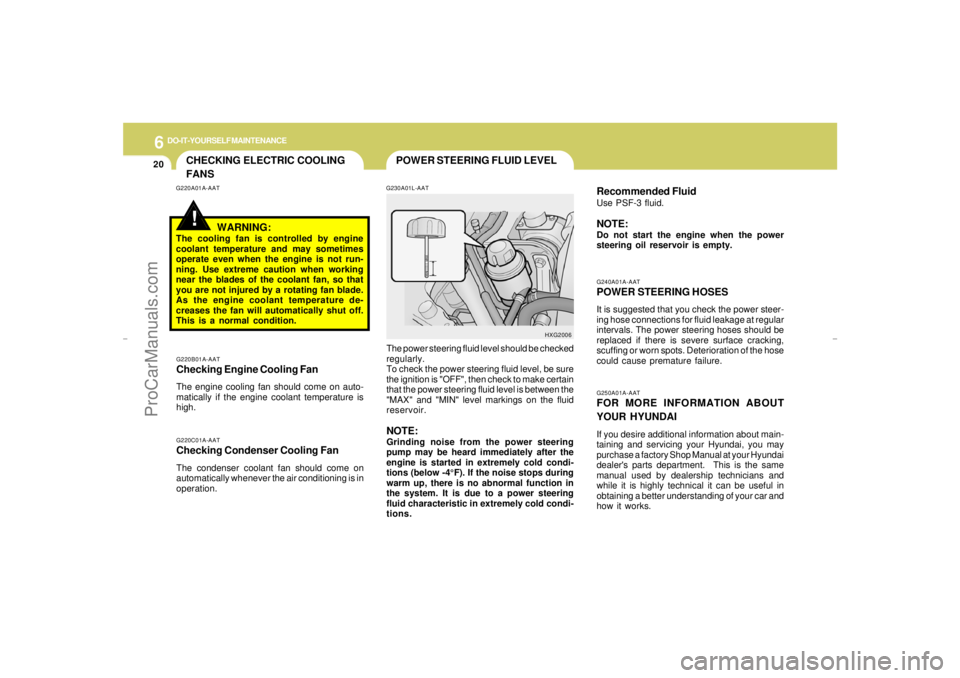
6
DO-IT-YOURSELF MAINTENANCE
20
POWER STEERING FLUID LEVEL
CHECKING ELECTRIC COOLING
FANS!
G250A01A-AATFOR MORE INFORMATION ABOUT
YOUR HYUNDAIIf you desire additional information about main-
taining and servicing your Hyundai, you may
purchase a factory Shop Manual at your Hyundai
dealer's parts department. This is the same
manual used by dealership technicians and
while it is highly technical it can be useful in
obtaining a better understanding of your car and
how it works.G240A01A-AATPOWER STEERING HOSESIt is suggested that you check the power steer-
ing hose connections for fluid leakage at regular
intervals. The power steering hoses should be
replaced if there is severe surface cracking,
scuffing or worn spots. Deterioration of the hose
could cause premature failure.
G230A01L-AAT
G220B01A-AAT
Checking Engine Cooling FanThe engine cooling fan should come on auto-
matically if the engine coolant temperature is
high.G220A01A-AAT
G220C01A-AATChecking Condenser Cooling FanThe condenser coolant fan should come on
automatically whenever the air conditioning is in
operation.
WARNING:
The cooling fan is controlled by engine
coolant temperature and may sometimes
operate even when the engine is not run-
ning. Use extreme caution when working
near the blades of the coolant fan, so that
you are not injured by a rotating fan blade.
As the engine coolant temperature de-
creases the fan will automatically shut off.
This is a normal condition.
The power steering fluid level should be checked
regularly.
To check the power steering fluid level, be sure
the ignition is "OFF", then check to make certain
that the power steering fluid level is between the
"MAX" and "MIN" level markings on the fluid
reservoir.
NOTE:Grinding noise from the power steering
pump may be heard immediately after the
engine is started in extremely cold condi-
tions (below -4°F). If the noise stops during
warm up, there is no abnormal function in
the system. It is due to a power steering
fluid characteristic in extremely cold condi-
tions.
HXG2006
Recommended FluidUse PSF-3 fluid.NOTE:Do not start the engine when the power
steering oil reservoir is empty.
xgflhma-6.p656/16/04, 2:59 PM 20
ProCarManuals.com
Page 201 of 247
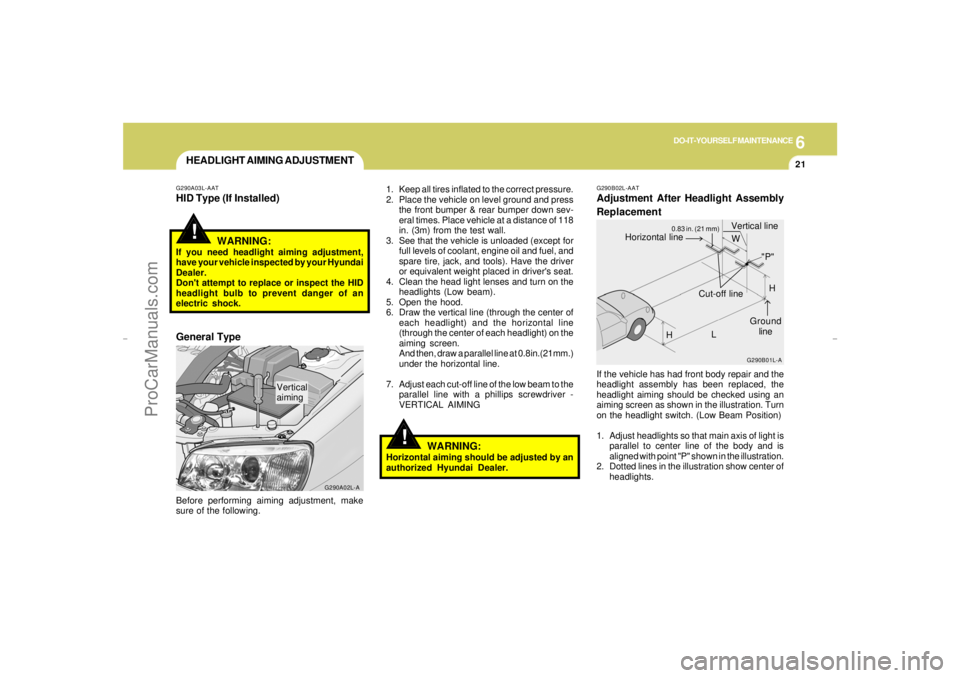
6
DO-IT-YOURSELF MAINTENANCE
21
HEADLIGHT AIMING ADJUSTMENT
!
!
G290A03L-AATHID Type (If Installed)Before performing aiming adjustment, make
sure of the following.
G290A02L-A
Vertical
aiming1. Keep all tires inflated to the correct pressure.
2. Place the vehicle on level ground and press
the front bumper & rear bumper down sev-
eral times. Place vehicle at a distance of 118
in. (3m) from the test wall.
3. See that the vehicle is unloaded (except for
full levels of coolant, engine oil and fuel, and
spare tire, jack, and tools). Have the driver
or equivalent weight placed in driver's seat.
4. Clean the head light lenses and turn on the
headlights (Low beam).
5. Open the hood.
6. Draw the vertical line (through the center of
each headlight) and the horizontal line
(through the center of each headlight) on the
aiming screen.
And then, draw a parallel line at 0.8in.(21mm.)
under the horizontal line.
7. Adjust each cut-off line of the low beam to the
parallel line with a phillips screwdriver -
VERTICAL AIMING
WARNING:
If you need headlight aiming adjustment,
have your vehicle inspected by your Hyundai
Dealer.
Don't attempt to replace or inspect the HID
headlight bulb to prevent danger of an
electric shock.General Type
WARNING:
Horizontal aiming should be adjusted by an
authorized Hyundai Dealer.
G290B02L-AATAdjustment After Headlight Assembly
ReplacementIf the vehicle has had front body repair and the
headlight assembly has been replaced, the
headlight aiming should be checked using an
aiming screen as shown in the illustration. Turn
on the headlight switch. (Low Beam Position)
1. Adjust headlights so that main axis of light is
parallel to center line of the body and is
aligned with point "P" shown in the illustration.
2. Dotted lines in the illustration show center of
headlights.
G290B01L-A
LW
H
HCut-off line
Ground
line
"P" Horizontal lineVertical line
0.83 in. (21 mm)
xgflhma-6.p656/16/04, 2:59 PM 21
ProCarManuals.com
Page 202 of 247
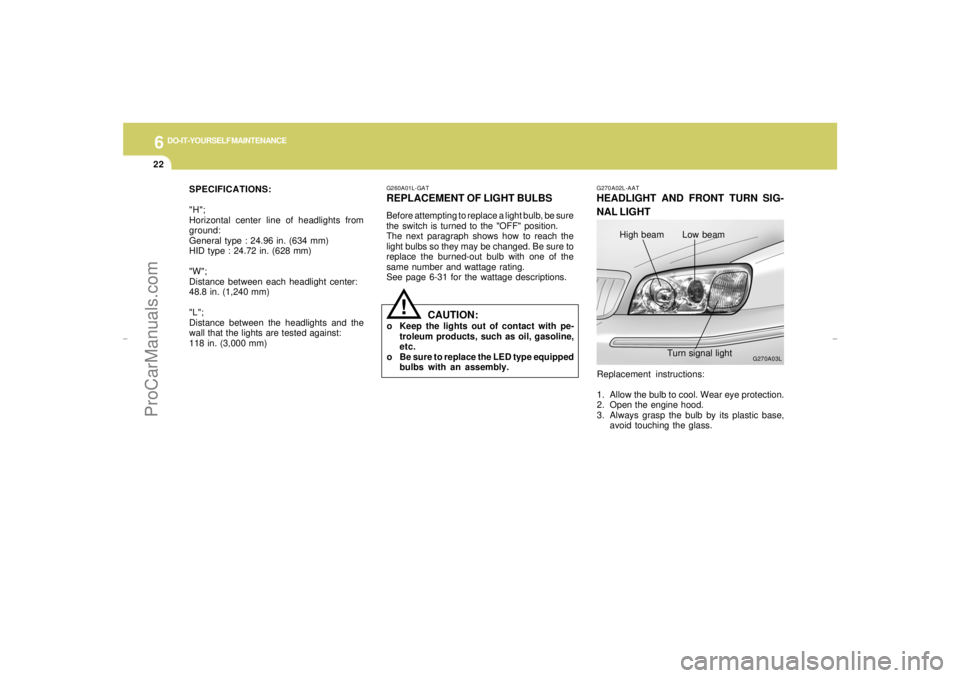
6
DO-IT-YOURSELF MAINTENANCE
22
Replacement instructions:
1. Allow the bulb to cool. Wear eye protection.
2. Open the engine hood.
3. Always grasp the bulb by its plastic base,
avoid touching the glass.
G260A01L-GATREPLACEMENT OF LIGHT BULBSBefore attempting to replace a light bulb, be sure
the switch is turned to the "OFF" position.
The next paragraph shows how to reach the
light bulbs so they may be changed. Be sure to
replace the burned-out bulb with one of the
same number and wattage rating.
See page 6-31 for the wattage descriptions.
G270A03L G270A02L-AAT
HEADLIGHT AND FRONT TURN SIG-
NAL LIGHT
High beam
Low beam
Turn signal light
!
CAUTION:
o Keep the lights out of contact with pe-
troleum products, such as oil, gasoline,
etc.
o Be sure to replace the LED type equipped
bulbs with an assembly. SPECIFICATIONS:
"H";
Horizontal center line of headlights from
ground:
General type : 24.96 in. (634 mm)
HID type : 24.72 in. (628 mm)
"W";
Distance between each headlight center:
48.8 in. (1,240 mm)
"L";
Distance between the headlights and the
wall that the lights are tested against:
118 in. (3,000 mm)
xgflhma-6.p656/16/04, 2:59 PM 22
ProCarManuals.com
Page 213 of 247
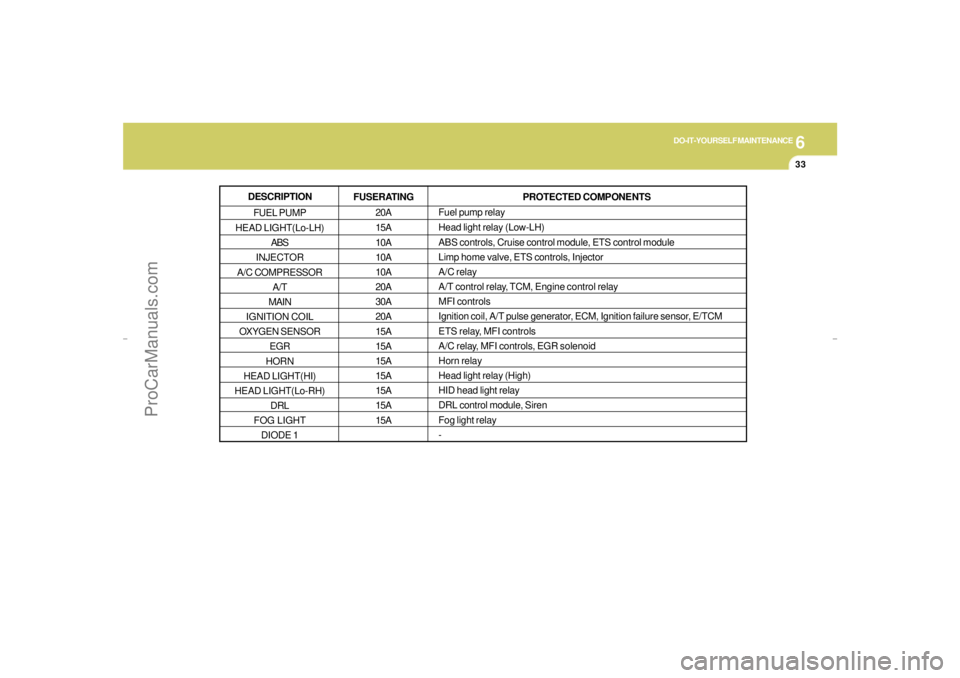
6
DO-IT-YOURSELF MAINTENANCE
33
DESCRIPTION
FUEL PUMP
HEAD LIGHT(Lo-LH)
ABS
INJECTOR
A/C COMPRESSOR
A/T
MAIN
IGNITION COIL
OXYGEN SENSOR
EGR
HORN
HEAD LIGHT(HI)
HEAD LIGHT(Lo-RH)
DRL
FOG LIGHT
DIODE 1FUSERATING
20A
15A
10A
10A
10A
20A
30A
20A
15A
15A
15A
15A
15A
15A
15AFuel pump relay
Head light relay (Low-LH)
ABS controls, Cruise control module, ETS control module
Limp home valve, ETS controls, Injector
A/C relay
A/T control relay, TCM, Engine control relay
MFI controls
Ignition coil, A/T pulse generator, ECM, Ignition failure sensor, E/TCM
ETS relay, MFI controls
A/C relay, MFI controls, EGR solenoid
Horn relay
Head light relay (High)
HID head light relay
DRL control module, Siren
Fog light relay
-
PROTECTED COMPONENTS
xgflhma-6.p656/16/04, 2:59 PM 33
ProCarManuals.com
Page 218 of 247
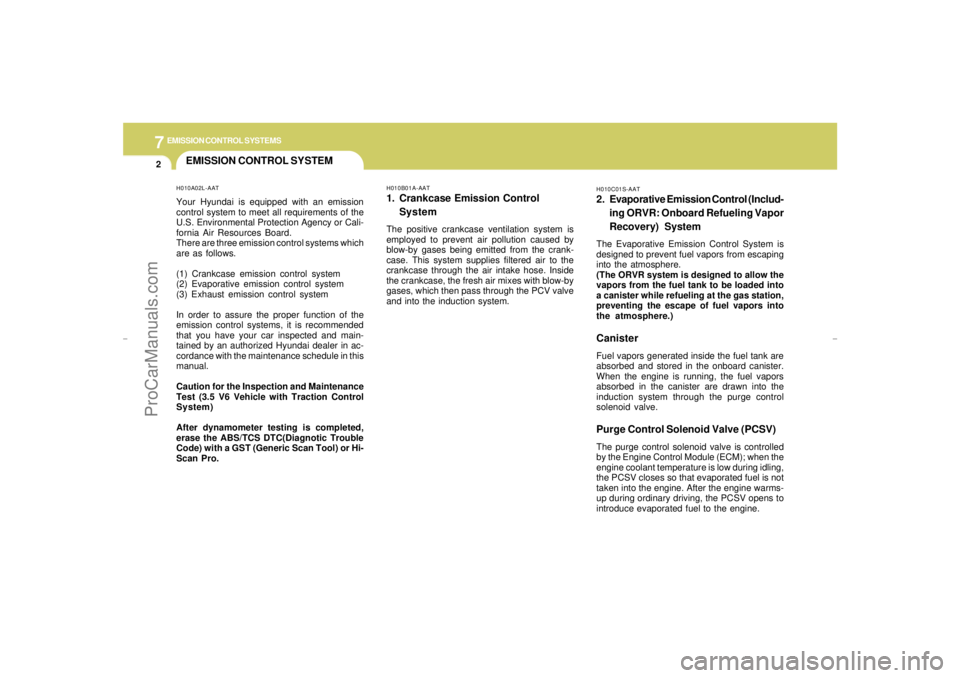
7
EMISSION CONTROL SYSTEMS2
EMISSION CONTROL SYSTEMH010A02L-AATYour Hyundai is equipped with an emission
control system to meet all requirements of the
U.S. Environmental Protection Agency or Cali-
fornia Air Resources Board.
There are three emission control systems which
are as follows.
(1) Crankcase emission control system
(2) Evaporative emission control system
(3) Exhaust emission control system
In order to assure the proper function of the
emission control systems, it is recommended
that you have your car inspected and main-
tained by an authorized Hyundai dealer in ac-
cordance with the maintenance schedule in this
manual.
Caution for the Inspection and Maintenance
Test (3.5 V6 Vehicle with Traction Control
System)
After dynamometer testing is completed,
erase the ABS/TCS DTC(Diagnotic Trouble
Code) with a GST (Generic Scan Tool) or Hi-
Scan Pro.
H010B01A-AAT1. Crankcase Emission Control
SystemThe positive crankcase ventilation system is
employed to prevent air pollution caused by
blow-by gases being emitted from the crank-
case. This system supplies filtered air to the
crankcase through the air intake hose. Inside
the crankcase, the fresh air mixes with blow-by
gases, which then pass through the PCV valve
and into the induction system.
H010C01S-AAT2. Evaporative Emission Control (Includ-
ing ORVR: Onboard Refueling Vapor
Recovery) SystemThe Evaporative Emission Control System is
designed to prevent fuel vapors from escaping
into the atmosphere.
(The ORVR system is designed to allow the
vapors from the fuel tank to be loaded into
a canister while refueling at the gas station,
preventing the escape of fuel vapors into
the atmosphere.)CanisterFuel vapors generated inside the fuel tank are
absorbed and stored in the onboard canister.
When the engine is running, the fuel vapors
absorbed in the canister are drawn into the
induction system through the purge control
solenoid valve.Purge Control Solenoid Valve (PCSV)The purge control solenoid valve is controlled
by the Engine Control Module (ECM); when the
engine coolant temperature is low during idling,
the PCSV closes so that evaporated fuel is not
taken into the engine. After the engine warms-
up during ordinary driving, the PCSV opens to
introduce evaporated fuel to the engine.
xgflhma-7.p656/16/04, 2:57 PM 2
ProCarManuals.com
Page 219 of 247
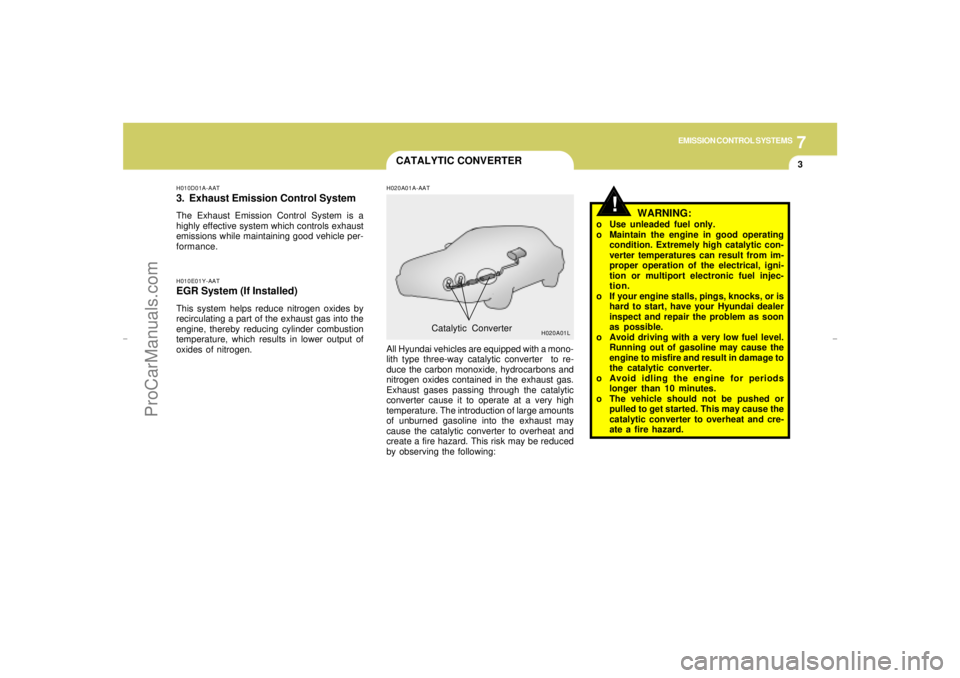
7
EMISSION CONTROL SYSTEMS
3
CATALYTIC CONVERTER
!
WARNING:
o Use unleaded fuel only.
o Maintain the engine in good operating
condition. Extremely high catalytic con-
verter temperatures can result from im-
proper operation of the electrical, igni-
tion or multiport electronic fuel injec-
tion.
o If your engine stalls, pings, knocks, or is
hard to start, have your Hyundai dealer
inspect and repair the problem as soon
as possible.
o Avoid driving with a very low fuel level.
Running out of gasoline may cause the
engine to misfire and result in damage to
the catalytic converter.
o Avoid idling the engine for periods
longer than 10 minutes.
o The vehicle should not be pushed or
pulled to get started. This may cause the
catalytic converter to overheat and cre-
ate a fire hazard.
H020A01A-AATAll Hyundai vehicles are equipped with a mono-
lith type three-way catalytic converter to re-
duce the carbon monoxide, hydrocarbons and
nitrogen oxides contained in the exhaust gas.
Exhaust gases passing through the catalytic
converter cause it to operate at a very high
temperature. The introduction of large amounts
of unburned gasoline into the exhaust may
cause the catalytic converter to overheat and
create a fire hazard. This risk may be reduced
by observing the following:Catalytic Converter
H020A01L
H010E01Y-AATEGR System (If Installed)This system helps reduce nitrogen oxides by
recirculating a part of the exhaust gas into the
engine, thereby reducing cylinder combustion
temperature, which results in lower output of
oxides of nitrogen.H010D01A-AAT3. Exhaust Emission Control SystemThe Exhaust Emission Control System is a
highly effective system which controls exhaust
emissions while maintaining good vehicle per-
formance.
xgflhma-7.p656/16/04, 2:57 PM 3
ProCarManuals.com
Page 220 of 247
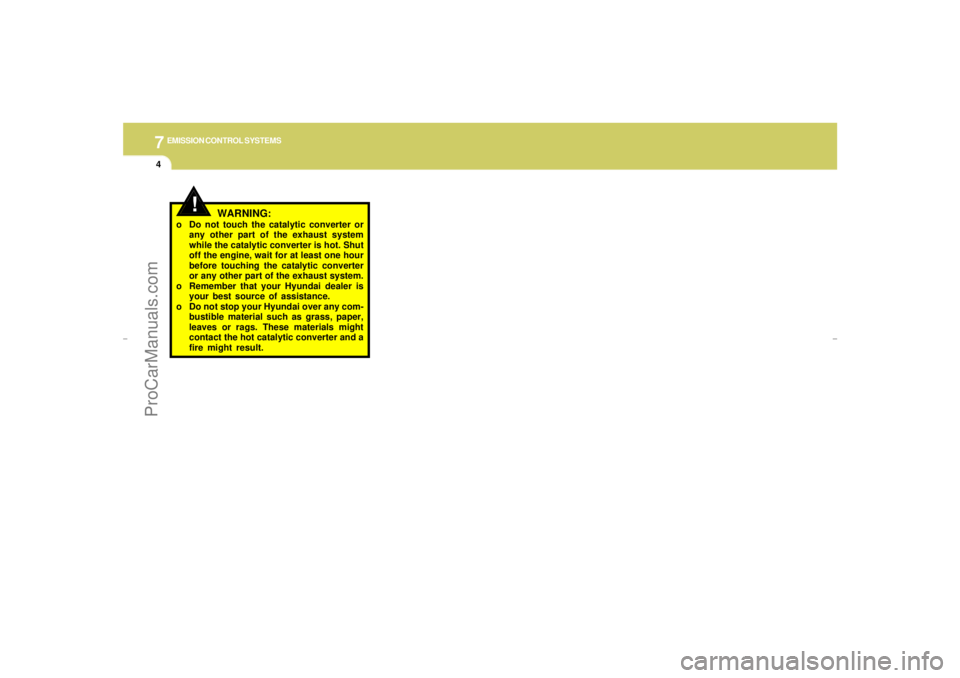
7
EMISSION CONTROL SYSTEMS4
!
WARNING:
o Do not touch the catalytic converter or
any other part of the exhaust system
while the catalytic converter is hot. Shut
off the engine, wait for at least one hour
before touching the catalytic converter
or any other part of the exhaust system.
o Remember that your Hyundai dealer is
your best source of assistance.
o Do not stop your Hyundai over any com-
bustible material such as grass, paper,
leaves or rags. These materials might
contact the hot catalytic converter and a
fire might result.
xgflhma-7.p656/16/04, 2:57 PM 4
ProCarManuals.com
Page 221 of 247

Vehicle Identification Number (VIN) .............................. 8-2
Engine Number ............................................................. 8-3
Recommended Inflation Pressures ............................... 8-4
Snow Tires..................................................................8-10
Tire Chains ..................................................................8-10
Tire Rotation................................................................8-10
Tire Balancing.............................................................8-11
Tire Traction................................................................8-11
When to Replace Tires ...............................................8-11
Spare Tire and Tools ...................................................8-12
Warranties for Your Hyundai Vehicle..........................8-12
Consumer Information.................................................8-13
Reporting Safety Defects............................................8-16
CONSUMER INFORMATION &
REPORTING SAFETY DEFECTS
8
8
xgflhma-8.p656/16/04, 2:57 PM 1
ProCarManuals.com
Page 222 of 247

8
CONSUMER INFORMATION & REPORTING SAFETY DEFECTS2
VEHICLE IDENTIFICATION
NUMBER (VIN)I010A02L-AATThe vehicle identification number (VIN) is the
number used in registering your car and in all
legal matters pertaining to its ownership, etc. It
can be found in four different places on your car:
I010A01L-1
1. On the bulkhead between the engine and
passenger compartments.
I010A02L
2. On the left top side of the instrument panel
where it can be seen by looking down through
the windshield.
I010A03L
xgflhma-8.p656/16/04, 2:57 PM 2
ProCarManuals.com
Page 223 of 247

8
CONSUMER INFORMATION & REPORTING SAFETY DEFECTS
3
I010A04L
I010A05L
3. On the left center pillar.
4. On the front lower side of the left center pillar
outer panel.
TIRE INFORMATIONI020A01A-AATThe tires supplied on your new Hyundai
are chosen to provide the best perfor-
mance for normal driving.
If you ever have questions about your
tire warranty and where to obtain ser-
vice, see the tire manufacture's booklet
included with your vehicle's Owner's
Manual Literature Kit.
I010B01A-AATEngine NumberThe engine number is stamped on the engine
block as shown in the drawing.
I010B01L
xgflhma-8.p656/16/04, 2:57 PM 3
ProCarManuals.com